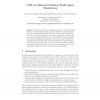Free Online Productivity Tools
i2Speak
i2Symbol
i2OCR
iTex2Img
iWeb2Print
iWeb2Shot
i2Type
iPdf2Split
iPdf2Merge
i2Bopomofo
i2Arabic
i2Style
i2Image
i2PDF
iLatex2Rtf
Sci2ools
CEEMAS
2001
Springer
2001
Springer
UML for Behavior-Oriented Multi-agent Simulations
Developing multi-agent simulations seems to be rather straight forward, as active entities in the original correspond to active agents in the model. Thus plausible behaviors can be produced rather easily. However, for real world applications they must satisfy some requirements concerning verification, validation and reproducibility. Using a standard framework for designing a multi-agent model one can gain further advantages like fast learnability, wide understandability and possible transfer. In this paper we show how UML can be used to specify behavior-oriented multi-agent models. Therefore we focus on activity graphs and the representation of different forms of interactions in these graphs. 1 Motivation A multi-agent model captures the behavior of a system on the level of the active entities and maps them onto simulated active entities. Thus, on a rather coarse grain level of analysis, it is far more intuitive to describe the model in terms s and roles, using goals or activities, t...
| Added | 28 Jul 2010 |
| Updated | 28 Jul 2010 |
| Type | Conference |
| Year | 2001 |
| Where | CEEMAS |
| Authors | Christoph Oechslein, Franziska Klügl, Rainer Herrler, Frank Puppe |
Comments (0)

